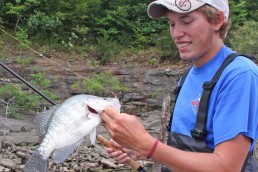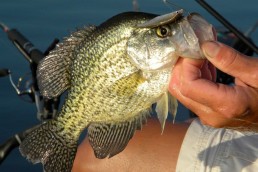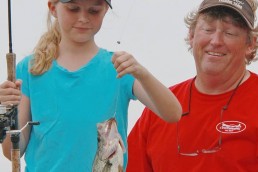Finding Crappies in Unusual Hiding Places
SHARE THIS POST
Crappies have several good characteristics with one of them being predictability—sometimes.
Once they are found today, they are likely to be there tomorrow. However, due to weather, water and the mood of fish, there are no guarantees of having a productive day. But you can add locations by finding surprise, “oddball” hot spots
Floating logs
Creeks and ditches receive the runoff when rains come, and rising water brings floating debris, sticks and trash. When the rise is large it includes logs.
Could these logs be a crappie pattern?
No doubt this is a long shot, but there have been situations when it’s worked. One particularly good situation happened to a friend when he thought he was fishing a stationary tree in a small creek. He soon learned the crappies were coming from a floating tree.
The log pattern can occur during terrible water conditions, so it is a long-shot spot at best. However, it’s something a fisherman should try when the opportunity is presented. Casting with a jig and float is one method; vertical jigging with a long pole is another.
Culverts
Culverts can be popular places, but most are ignored. The best time to try them is after rainfall. A culvert drains a tributary—ditch, creek, low-water area or watershed—into a main lake. Moving water can bring crawfish, shad, small minnows and other food. Crappies and other predators move into strategic ambush locations to feed when this happens. Try all water areas when fishing a culvert. In general, crappies hate current, so expect them to be in small eddy areas or behind cover, and the slack-water areas are the best places.
Culvert crappies can be jigged, but a heavier 1/8-ounce jig will help in currents. The stained water runoff calls for bold colors too, including yellow, orange and black.
Are you enjoying this post?
You can be among the first to get the latest info on where to go, what to use and how to use it!
Another presentation is a slip float and minnow. Casting a float allows the minnow to flow with current, even in an eddy, so the bait is floating naturally to fish. The float usually stops in the slowest current spot where fish are most likely to be holding.
Floating moss
Another surprise spot can be found in shallow, stumpy areas of a lake. Moss, weeds or grass can break loose and float. When the floating vegetation hangs up on a stump it creates a hot spot. The best spots might have to be watched for a minute to see if a patch is moving or if it’s still. If it’s not moving it’s probably hung up on a stump. The spot becomes wood cover with an “umbrella” on top providing shade—that’s a good combination.
The spot can be difficult to fish though. A long 10- or 12-foot jigging pole allows a slow presentation of a jig or minnow around the spot. Be sure to avoid throwing trolling motor backwash into this area.
Cobwebs
This recommendation came from a pair of fishermen in Indiana who spend a lot of time on the water. They pay close attention to a cobweb pattern when fishing pressure is heavy.
High fishing pressure means the visual cover is getting fished multiple times. The trick to improve the catch ratio is to first form a pattern of cover and depth which crappies prefer. Once learned, they target the right wood at the right depth. They limit their fishing then to those spots with cobwebs. A cobweb means that the stick or stump hasn’t been fished for a day or two, and that’s where to put your bait.
The cobweb pattern does one obvious thing to improve percentages, and that is searching new water verses fishing water that has already been fished. A long, sensitive jigging pole is used to break the cobweb and lower the bait beside the cover. A thorough presentation is then made, giving crappies time to take the bait.
More spots
There are no limits to hot spots. When a location or piece of cover looks like a non-typical spot, it’s something a fisherman should give a quick try. Don’t waste too much time, but at least give it a shot and possibly create your own surprise, oddball hot spot. MWO
MWO
SHARE THIS POST
Did you enjoy this post?
You can be among the first to get the latest info on where to go, what to use and how to use it!
Tim Huffman
Tim Huffman specializes in crappie fishing, is editor for two crappie magazines, as well as writing for several others. In 2018, he published his sixth book, Limiting Out for Crappie, available at Amazon. His first article appeared in MidWest Outdoors in 1988.



